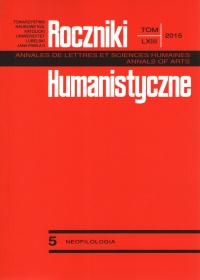Spatial Ontologies of (Neo)Baroque Culture
Abstrakt
Przestrzenne ontologie (neo)barokowej kultury
Celem artykułu jest spojrzenie na przestrzeń przez pryzmat teorii neobaroku. Artykuł próbuje pokazać, jak barokowe strategie obramowywania i przełamywania ram przekształcają płaszczyznę w przestrzeń usytuowaną wewnątrz podmiotu. Artykuł analizuje również sposób, w jaki przełamywanie ram reprezentacji może być postrzegane jako akt ontologiczny uzależniony od ciała i pożądania, akt, dzięki któremu możliwa staje się estetyzacja rzeczywistości.
Bibliografia
Baudrillard, Jean. Symulakry i symulacja. Translated by Sławomir Królak. Warszawa: Wydawnictwo Sic!, 2005.
Calabrese, Omar. Neo-Baroque: A Sign of the Times. Translated by Charles Lambert. Princeton, NJ: Princeton University Press, 1992.
Casey, Edward S. The Fate of Place: A Philosophical History. Berkeley: University of California Press, 1998.
d’Ors. Eugenio. “The Debate on the Baroque in Pontigny.” Translated by Wendy B. Farris. In Baroque New Worlds: Representation, Transculturation, Conterconquest, edited by Lois Parkinson Zamora and Monika Kaup, 78–92. Durham: Duke UP, 2012.
Egginton, William. “Reality is Bleeding. A Brief History of Film from the Sixteenth Century.” Configurations 9 (2001): 207–229.
Egginton, William. The Theater of Truth: The Ideology of (Neo)Baroque Aesthetics. Stanford: Stanford UP, 2010.
Habermas, Jürgen. The Philosophical Discourse of Modernity: Twelve Lectures. Translated by Frederick Lawrence. Cambridge: Polity Press, 1998.
Harries, Karsten. “Space, Place and Ethos: Reflections on the Ethical Function of Architecture.” Artibus et Historiae. 5.9 (1984): 159-165.
Harries, Karsten. The Broken Frame: Three Lectures. Washington, D.C.: Catholic University of America Press, 1990.
Harvey, David. The Condition of Postmodernity: An Enquiry into the Origins of Cultural Change. Cambridge: Blackwell, 1992.
Horkheimer, Max and Theodor W. Adorno. Dialectic of Enlightenment: Philosophical Fragments. Translated by Edmund Jephcott. Stanford: Stanford University Press, 2002.
Jameson, Fredric. Postmodernism, or, The Cultural Logic of Late Capitalism. London: Verso, 1991.
Judovitz, Dalia. The Culture of the Body: Genealogies of Modernity. Ann Arbor: University of Michigan Press, 2001.
Lambert, Gregg. The Return of the Baroque in Modern Culture. New York and London: Continuum, 2004.
Maravall, José Antonio. Culture of the Baroque: Analysis of a Historical Structure. Translated by Terry Cochran. Minneapolis: University of Minnesota Press, 1986.
McHale, Brian. Postmodernist Fiction. London: Routledge, 2004.
Nietzsche, Friedrich. “On the Baroque.” Translated by Monika Kaup. In Baroque New Worlds: Representation, Transculturation, Conterconquest, edited by Lois Parkinson Zamora and Monika Kaup, 44–45. Durham: Duke UP, 2012.
Sarduy, Severo. “Baroque and Neobaroque.” Translated by Christopher Winks. In Baroque New Worlds: Representation, Transculturation, Conterconquest, edited by Lois Parkinson Zamora and Monika Kaup, 270–291.. Durham: Duke UP, 2012.
Sherwin, Richard K. Visualizing Law in the Age of the Digital Baroque: Arabesques and Entanglements. New York: Routledge, 2011.
Stewart, Elizabeth. Catastrophe and Survival: Walter Benjamin and Psychoanalysis. New York: Continuum, 2010.
Wölfflin, Heinrich. Renaissance and Baroque. Translated by Kathrin Simon. Ithaca: Cornell UP, 1990.
Copyright (c) 2015 Roczniki Humanistyczne

Utwór dostępny jest na licencji Creative Commons Uznanie autorstwa – Użycie niekomercyjne – Bez utworów zależnych 4.0 Międzynarodowe.





